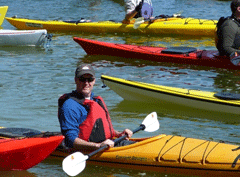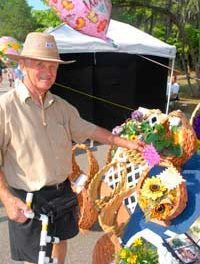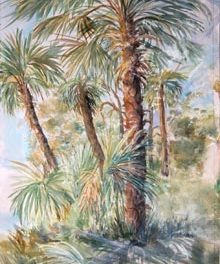Deborah S. Johnson, B3C Project Coordinator, sums up the past three years.
The Beginning
On January 17, 1711, or 1.17.1711 if one (not 1) is inclined towards numerology, the Lords Proprietor a great distance away across the Atlantic Ocean in England decreed the following: “…We therefore being desirous to render the province of Carolina as useful as may be to this her Majesty’s Kingdom of Great Britain and also considering what great tracts of sand are lying upon the said River of Port Royal which may afford great quantities of Naval Stores have given directions for the building of a Town called Beaufort Town…”Fast forward 297 years to the autumn of 2007 as a dozen or so people sat around Billy Keyserling’s living room on this side of the Atlantic Ocean in this now seasoned town of Beaufort and pondered the notion of what a 300th anniversary of this charter might mean to a city such as ours. Billy was not mayor then, nor was he in any elected office, and the anniversary was more than three years away. However, he did not want to let such an important occasion slip up on us without the community being prepared for this exceptional event. He had called together our informal group of journalists, historians, educators, librarians and community leaders to consider this. There was talk of newcomers loving Beaufort and volunteering for service on commissions and committees, but often looking to where they came from for solutions and models. Why didn’t people first look to Beaufort’s history and past experiences? Perhaps, because they did not know of its rich traditions, innovations, culture and historical significance? There was also talk of long-time Beaufortonians and how to tap their knowledge and experiences and document this living history in some manner similar to the award-winning Downtown as a Classroom projects led by Margaret Rushton in the Beaufort County schools. Billy said “hometown” a lot. Others spoke of favorite memories. The word “future” crept into the conversation as a complement to the word “past” and before we knew it, there was a project in the works.
The group grew to nearly 20 and gathered for several meetings at Billy’s Ribaut Road home. We sipped beverages and gazed out the east living room window at boats bobbing in the aforementioned naval stores laden Beaufort River, the downtown roofscape and the Woods Memorial Bridge in the distance. No one needed convincing that this was important. Billy offered to put up seed money and secure project funding; I was asked to be the part-time coordinator; and all in the room agreed to serve on the Steering Committee to vet ideas and keep the project on track, whatever that track might turn out to be. Models were considered, a mission statement was written, and the Steering Committee was formalized to include a few more members. On a cold and drizzly January 17, 2008, the Beaufort Three-Century Project was launched at a warm and lively reception in the historic Anchorage House. We made a three-year commitment—funds would be raised, volunteers would be recruited, and projects within the project would be created. The people of Beaufort would craft a very special birthday gift for our town.
From the onset, B3C as it affectionately came to be known, was intended to be as inclusive as possible to engage people in learning about and caring about our history while using this knowledge to help frame the future. We knew some tangible items would result to create an archive of what was learned, but the underlying goal was to involve as many people and as diverse a group of people as we could muster. And, there was a defined beginning—January 17, 2008—and a defined ending—January 17, 2011.
The Middle
Speeches were made to Rotary clubs, leadership groups and garden clubs. Meetings were held with city and county officials. Members of the Chamber of Commerce, Main Street, Historic Beaufort Foundation, Beaufort County Historical Society, University of South Carolina Beaufort, Technical College of the Lowcountry, Beaufort County schools, among others, were invited to become part of it. Grant applications were written and a charitable fund was established at the Community Foundation of the Lowcountry. Generous people let us use meeting rooms, event facilities, and donated office space. A logo was designed and a website was created through more community largesse.
The people of Beaufort embraced the concept and project ideas flowed like a full moon spring tide—sometimes fast and hard and a bit over-whelming, other times halting or slowly reversing direction. Over the course of three years, numerous projects were initiated and an estimated 3,000 to 4,000 people of varied ages, backgrounds, and interests participated. As a volunteer-based initiative, understandably not everything planned was implemented or completed, but new projects sprouted from interesting places and dedicated people. Looking back—the mantra for the B3C—an astonishing array of 42 unique events and endeavors took place. There were lectures, forums, films, symposia, oral histories, books, exhibitions, and archives. There were local experts, internationally renowned experts, long scholarly projects and short, just-for-fun projects.
The Ending
One of the original tenets of this project was that by exploring our past and talking about what we value, a vision might be formed to guide our future—not a city planning document sort of vision with goals and objectives, but a shared community understanding that would serve as a framework for decision-making. It was thought that the Ancestors to Future Generations forum series would lay the groundwork and to some degree that occurred. Many topic-based concepts came from those forums and are documented in the archival videos and written summaries.
An aftermath of B3C might include a B4C group reviewing and massaging the information from those forums to create a clearer understanding of what was shared and how it might be used in the future. There was just not enough time left in B3C’s self-mandated lifespan to adequately and thoughtfully complete this complex undertaking.
However, it is my belief that the vision derived from the three years of exploration is blatantly woven in the common threads that run through many of the projects, interviews, creative endeavors, as well as the formal discussions. Most of the people interviewed for the 300 Stories project or those who participated in the forum dialogue echoed the same five common elements that define Beaufort:
• The water…it surrounds us and supports us.
• The beauty…it is rare and stunning and pervasive.
• The people…they are caring and friendly and inclusive in a way that is hard to describe, but is different than other places.
• The history…it is rich and diverse.
• The culture…it is distinctive and we have long been a place of the arts and learning.
In every future decision, we might ask ourselves, “Will this adversely affect the characteristics that make Beaufort special?” If the answer is “yes,” then don’t do it!
We might also ask, “Will this protect and advance the characteristics that make Beaufort wonderfully unlike other places?” If the answer is “yes,” then go forth with speed and determination!
On December 31, 2010, the City of Beaufort’s Tricentennial commemoration began, and will be a year-long celebration of activities and events planned by a city committee. B3C’s public role officially concludes on January 17, with the 300th-year marking of the City’s charter, a quiet passing of the archive to the Beaufort District Collection at the Beaufort County Library will be the final act of the Beaufort Three-Century Project. However, the website will remain as a community resource throughout 2011 and the legacy of the hundreds of people who worked on this project will live on not only in the archive, but in the hearts and minds of all who participated—those who learned more about this incredible place we call home, shared ideas about what our past means for our future, and engaged in a community conversation about the wonderful sense of place that defines us.









